 |
Sources of resistance to diseases and pests in cotton (Gossypium hirsutum L.) |
Dr. Sergey Grigoryev
|
 |
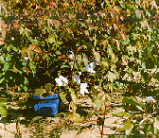 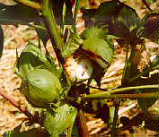 Resistance of cotton to wilt and various afflicting pests - is one of the main problem of cotton cultivation in any cotton-growing country. Doubtlesly, this problem of resistance will also be faced in areas where the cultivation of cotton begins to develop. Resistance of cotton to wilt and various afflicting pests - is one of the main problem of cotton cultivation in any cotton-growing country. Doubtlesly, this problem of resistance will also be faced in areas where the cultivation of cotton begins to develop.
The Department of Industrial Crops of VIR is carrying out research on cotton (breeding of early-ripening, high-yielding lines, the study of diseases, pests and other limiting factors) in southern Russia (Astrakhan province). There are large vegetable and melon growing areas in this province, so cotton may be afflicted by various diseases and pests. Wilting and damage with corn stem borer (Ostrinia nubilalis Hb.) were studied at the Astrakhan Experiment Station of VIR.Wilting and affection with sucking pests have been studied in Central Asia and results are shown below.
Materials
The main part of accessions used in the research are lines which have been obtained through intraspecific hybridisation of G.hirsutum L. varieties with amphiploids of species G.lobatum Gen., G trilobum Skov., G.harknesii Brand., and form G.hirsutum L., ssp. purpurascens. Also accessions originating from Uzbekistan, India, Brazil, Peru, USA, and Bulgaria were used in the research.
Resistance to wilt
Wilting is a fungous disease caused by Verticillium dahliae Kleb. that damages about 600 plant species of various families: vegetables, melons, trees, bushes and various weeds. For example, the extracted races T-1 and SS-4 which are aggressive to G. hirsutum and G. barbadense, are at the same time pathogenic for commercial varieties of tomato (Licopersicum esculentum Mill.) and olives (Olea europea L.).
In spite of polyphagy of wilt fungus, recent researches show the pathogenic specialisation of wilt in plant species, as well as the specialisation in different varieties of G. hirsutum. So, the search for sources and donors of resistant cotton in different geographical areas is highly actual.
Sources of resistance to wilt in Southern Russia
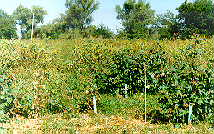
The cotton lines, resistant to wilt (right),
as compared with afflicted ones (left) |
The quantity of fungous inoculum in soil may be very high in conditions of saturated melon-vegetable crop rotation in Astrakhan province. So, the search for cotton forms which are resistant to wilt is highly desirable. Cultivation of such forms also leads to reducing the rate of soil infection. The breeding and study of lines have been carried out since 1997 at the Astrakhan Station of VIR. 42 accession and lines were studied in 1999 in several replications against natural wilt background. Plants affection with wilt was recorded as per September 15 against a 6-point scale, where "0" is the absence of damage, and "5" – the dead plant. Values of wilt affection have been subjected to the LSD analysis. The most resistant lines and accessions were marked as Group I of resistance, and the highly afflicted ones - as Group IV.
Resistance to wilt (Verticillium dahliae Kleb.) of G.hirsutum accessions, 1999. Astrakhan province (Southern Russia):
| Name and origin |
Average rate
of wilting |
Group of
resistance |
| 124P, Uzbekistan |
0.00 |
I |
| 4W3, Uzbekistan |
0.00 |
I |
| 92P, Uzbekistan |
0.00 |
I |
| 92W, Uzbekistan |
0.00 |
I |
| Namangan 77, Uzbekistan |
0.00 |
I |
| Ku 1, Uzbekistan |
0.09 |
I |
| 109W, Uzbekistan |
0.16 |
I |
| 43P, Uzbekistan |
0.20 |
II |
| Sindos 80, Italy |
0.45 |
II |
|
| Name and origin |
Average rate
of wilting |
Group of
resistance |
| Fergana 3, Uzbekistan |
0.20 |
II |
| Ak 1, Uzbekistan |
0.25 |
II |
| Djum, Uzbekistan |
0.60 |
II |
| 11-97-7, Kote d’Ivoire |
0.77 |
III |
| CV1017, Bulgaria |
1.12 |
III |
| Xudkar, Uzbekistan |
1.50 |
III |
| Tamcot CDSTE , USA |
2.00 |
IV |
| CV1358, Bulgaria |
3.00 |
IV |
| |
|
|
|
The most resistant lines (average rate of damage - 0.00) have been created on the basis of intraspecific hybridisation of cotton.
Sources of resistance to wilt in Central Asia
Wilt is the most harmful disease in main cotton-growing areas of Central Asia. Screening of tolerant breeding lines has been carried out against natural highly aggressive wilt background, where cotton has been cultivated for 50 years without crop rotation. Plants affection with wilt was recorded as per October 1 against a 6-point scale. The most resistant lines were marked as Group I of resistance, and the highly afflicted ones - as Group V.
Resistance to wilt (Verticilliun dahliae Kleb.) of G.hirsutum accessions, 1990 - 1995, Uzbekistan:
| Name and origin |
Average rate
of wilting |
Group of
resistance |
| 112P, Uzbekistan |
0.21 |
I |
| 32P, Uzbekistan |
0.28 |
I |
| 71P, Uzbekistan |
0.50 |
I |
| 81P, Uzbekistan |
0.67 |
I |
| 96P, Uzbekistan |
0.73 |
I |
| 914P, Uzbekistan |
0.95 |
I |
|
| Name and origin |
Average rate
of wilting |
Group of
resistance |
| 33P, Uzbekistan |
1.00 |
II |
| 91P, Uzbekistan |
1.12 |
II |
| 43P, Uzbekistan |
1.14 |
II |
| 51P, Uzbekistan |
3.14 |
III |
| C-4727, Uzbekistan |
5.00 |
V |
| |
|
|
|
Sources of resistance of cotton (G.hirsutum.L) to stem border (Ostrinia nubilalisHb.) in Southern Russia
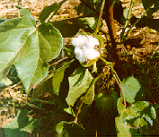 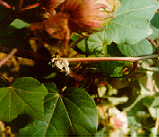 Cotton also may be heavily afflicted by corn stem borer (Ostrinia nubilalis Hb.) known in North America as the European corn borer. The heaviest damage is caused on lowlands and moist arable lands suitable for cotton cultivation, along riverbanks, especially under the conditions of high summer temperatures combined with high air humidity. Cotton also may be heavily afflicted by corn stem borer (Ostrinia nubilalis Hb.) known in North America as the European corn borer. The heaviest damage is caused on lowlands and moist arable lands suitable for cotton cultivation, along riverbanks, especially under the conditions of high summer temperatures combined with high air humidity.
O.nubilalis infects a wide variety of crops. 40 plant families are afflicted in the USA and 47 species of cultivated plants and 101 species of weeds are afflicted by the pest within the former USSR. Besides cotton, the heaviest damage is reported on corn in large corn-growing areas in the foothills and plains in southern Russia, as well on cultivated hemp, millet and hop. Moderate damage is reported on sunflower and potato. Artemisia vulgaris L. is the most commonly infected weed.
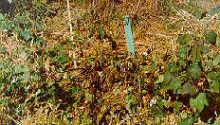
The accession highly damaged by
stem borer (O.nubilalis) |
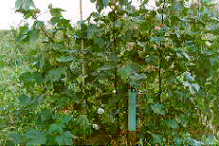
The accession resistant
to stem borer and wilt |
The lines were studied against natural pest background. The high density of weeds on trial plots promotes the high quantity of pests. Pest damage to plants was recorded on September 15 against a 3-point scale, where "0" s the absence of damage, and "2" is the plant's broken stem. Values of affection have been subjected to the LSD analysis. The most resistant lines and accessions were marked as Goup I of resistance, and the highly damaged ones as Group IV (see Table 3).
Resistance to Ostrinia Nubilalis Hb. of G.hirsutum L. accessions, 1999, Astrakhan province (Southern Russia):
| Name and origin |
Average rate
of wilting |
Group of
resistance |
| 32P, Uzbekistan |
0.00 |
I |
| PH 93, India |
0.00 |
I |
| 11-97-7, Kote d’Ivoire |
0.10 |
I |
| 109W, Uzbekistan |
0.16 |
I |
| Ku1, Uzbekistan |
0.18 |
I |
| Ak1, Uzbekistan |
0.55 |
I |
| Namangan 77, Uzbekistan |
0.62 |
II |
| 124P, Uzbekistan |
1.00 |
II |
|
| Name and origin |
Average rate
of wilting |
Group of
resistance |
| 43P, Uzbekistan |
1.00 |
II |
| 92P, Uzbekistan |
1.10 |
II |
| Djum, Uzbekistan |
1.10 |
II |
| 31P, Uzbekistan |
1.33 |
III |
| 45P, Uzbekistan |
1.50 |
III |
| 4W3, Uzbekistan |
1.60 |
III |
| 92W, Uzbekistan |
1.67 |
III |
| Sindos 80, Italy |
1.75 |
IV |
|
Sources of resistance of cotton (G.hirsutum L.) to sucking pests and wilt in Central Asia
Sucking pests cause direct damage of plants and reduce the ontogenetic resistance of cotton to fungous and bacterial diseases as well. The amphiploids used in the research have been obtained through intraspecific hybridisation of G.hirsutum L. varieties with wild species. Letters AP standing before the name of the incorporated wild species designate the amphiploid forms.
The hybrids of amphiploids with C-4880 variety also were used in the research. The lines were studied in several replications in Uzbekistan against natural infestation background. Plants affection with sucking pests (Aphis gossypi Glov. and Tetranychus telarius L.) was recorded against a 6-point scale, where "0" is the slight damage, and "5" - falling of the damaged leaves. The most resistant accessions were marked as Group 0 of resistance.
| Accessions |
Average rate of damage by Aphis gossypi |
Average rate of damage by Tetranychus telarius |
Resistance
to wilt, % |
| AP G.sturtii |
0 |
0 |
100 |
| F2 (AP G. sturtii x C-4880) |
1 |
1 |
89.7 |
| AP G.lobatum |
0 |
0 |
81.8 |
| F2 (AP G.lobatum x C-4880) |
1 |
0 |
72.7 |
| AP G.trilobum |
1 |
2 |
85.7 |
|
| Accessions |
Average rate of damage by Aphis gossypi |
Average rate of damage by Tetranychus telarius |
Resistance
to wilt, % |
| F2 (AP G.trilobum x C-4880) |
1 |
3 |
83.7 |
| AP G.harknessii |
3 |
4 |
78.6 |
| F2 (AP G.harknessii x C-4880) |
3 |
4 |
75.0 |
| Tashkent 1 |
4 |
5 |
26.1 |
| C-4880 |
3 |
4 |
30.2 |
|
| Sources of resistance to diseases and pests in cotton (Gossypium hirsutum L.) |
 |
|



 Resistance of cotton to wilt and various afflicting pests - is one of the main problem of cotton cultivation in any cotton-growing country. Doubtlesly, this problem of resistance will also be faced in areas where the cultivation of cotton begins to develop.
Resistance of cotton to wilt and various afflicting pests - is one of the main problem of cotton cultivation in any cotton-growing country. Doubtlesly, this problem of resistance will also be faced in areas where the cultivation of cotton begins to develop.


 Cotton also may be heavily afflicted by corn stem borer (Ostrinia nubilalis Hb.) known in North America as the European corn borer. The heaviest damage is caused on lowlands and moist arable lands suitable for cotton cultivation, along riverbanks, especially under the conditions of high summer temperatures combined with high air humidity.
Cotton also may be heavily afflicted by corn stem borer (Ostrinia nubilalis Hb.) known in North America as the European corn borer. The heaviest damage is caused on lowlands and moist arable lands suitable for cotton cultivation, along riverbanks, especially under the conditions of high summer temperatures combined with high air humidity.


